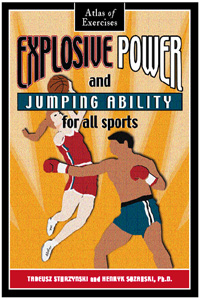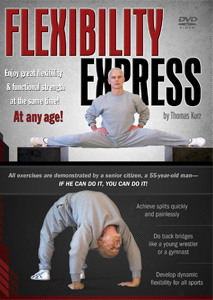by Thomas Kurz
In the previous articles on strength training you learned about the kinds of strength–from static strength to explosive strength.
Apart from the type of strength that your exercises develop, you need to be concerned also with form and timing of movement. What matters is where (at which angle in the range of movement) and when (at which instant) you get stronger. The common fallacy of strength training is believing that you exercise muscles and not movements. The human mind directs movements. Only after a movement is “ordered” do the brain and the higher levels of the spinal cord specify, without your conscious control, which muscles will do what and when. This is why you should use natural movements for both general and sport-specific strength exercises rather than isolate muscle groups with artificial, bodybuilding-like exercises. There is no isolation in any natural movement, be it lifting, jumping, pushing, or pulling and there is no isolation in any of your techniques. Isolation is a concept of bodybuilding (which is looks-oriented) and has little or no application in strength training for action.
Misconceptions regarding strength training are common. For example, Matt Brzycki, strength coach at Princeton University, said “You won’t develop one way with machines and another with barbells, assuming that your levels of intensity are similar with both modalities. And since your muscles don’t have a brain, eyeballs, or cognitive ability, they can’t possibly ‘know’ the source of the workload.” (Brzycki 1994).
Well, it just isn’t so. Exercises of any kind affect the whole body, muscles as well as the nervous system. Muscles do have eyes and a brain—your eyes and your brain. The only muscles that do not have them are those separated from the body and experimented on in a laboratory.
Coach Brzycki’s statement applies to increasing muscle mass and raw–not sport-specific–strength but not to sport-specific strength training. Look at Olympic weightlifters’ workouts and see if they use any machines. If it did not matter whether weightlifters used machines or free weights, they would develop technique with broomsticks and strength with machines, which are easier and safer to work with.
Another misconception is that “skill training and conditioning are specific to a sport, but strength training is general . . . ” (Brzycki 1994). There is too much research that contradicts this to list all of it here. Here is one example of a sport-specific strength exercise: Six weeks of practicing volleyball spikes with a 1-lb. weighted glove increased velocity of the players’ spike. Tests of triceps and shoulder of their hitting arm on the isokinetic machine, however, did not show any relationship to the velocity of their spike. (Some players did increase strength in the shoulder and elbow extensors, but these improvements were not consistent for all players and probably do not explain increases in spike velocity.)
The researchers speculate that improved velocity was the result of some change in technique caused by wearing weighted gloves or some change in the nervous system rather than in the muscles (Carlson et al 1998).
Another example: Jumps preceded by a short step or a jump (landing and immediately jumping again) increase the height of a jump from standing in place much more than the other way around. This is because jumps “from a landing” require and perfect reactive strength and starting strength (see definitions in “Sports Skills and Strength Training, Part II”)—the nervous system’s abilities to mobilize one’s strength very quickly (Wazny 1981b).
To sum it up: Sport-specific strength exercises must take into account the form and timing of movement because of the nervous system’s role in strength improvement.
Form of Movement
You should make your sport-specific strength exercises as similar to your technique as possible. The practice of volleyball spikes with a weighted glove is a good example. At the very least do exercises in the same movement pattern as your technique. For example, in hip flexor exercises for sprinters, let your left leg hang below the bench (to put it through the same range of motion [ROM] as when sprinting), and as you raise your left leg simultaneously press your right leg to the back and extend your left arm to the back while moving your bent right arm forward and across your chest. This synchronization of limb movements is the same pattern as that used in running. Thanks to spinal cord reflexes (flexor reflex afferent pathways), these additional movements of the arms and the other leg increase the tension of muscles lifting the left leg. This pattern is similar to that of karate’s front, side, and roundhouse kicks.
Right Resistance
The amount of resistance in sport-specific exercises has to ensure duplication of intermuscular and intramuscular coordination. If resistance is too great, the movement may resemble the external form of the technique, but it will require different coordination than the one that is best in the technique. For example, the intermuscular and intramuscular coordination in throwing a 1.5 kg ball using the technique of a javelin throw without a prerun is the same as in throwing a 0.8 kg javelin. In throwing a 4 kg ball in the same fashion, the external form resembles the javelin throw, but the muscular coordination registered by an EMG (Electromyograph) is different. The throw with a 1.5 kg ball can be used as a sport-specific strength exercise, but the throw of a heavier ball may be used only as a directed strength exercise (Wazny 1981a). In high jumping, vests with weights amounting to no more than 5% of the body weight are used in training forms of competitive exercises (Matveev 1981). If the time, rhythm, or spatial form of technique changes with a given amount of resistance, then the resistance is too great.
Sometimes an athlete has to use much greater resistance than what he or she is currently able to overcome using full technique. This can be done by starting the movement from an easier position or performing only a part of the technique—for example, in weightlifting, jerking the barbell up from a rack (Matveev 1981).
In Part VI of “Sports Skills and Strength Training” you will learn about the danger of an inappropriate use of sport-specific strength exercises.
References
Brzycki, M. 1994. “Strength Training: On the March.” Scholastic Coach vol. 64, no. 1, pp 29-30.
Carlson, C., Gayle, R., and Pratt, L. 1998. “The Effects of Weighted Implement Training on the Velocity of the Volleyball Spike.” Research Quarterly for Exercise and Sport vol. 69, no. 1 Supplement, p. A-17.
Matveev, L. P. 1981. Fundamentals of Sports Training. Moscow: Progress Publishers.
Wazny, Z. 1981a. Sila Miesniowa. In Teoria i Metodyka Sportu, ed. T. Ulatowski. pp. 110-36. Warsaw: Sport i Turystyka 1981.
Wazny, Z. 1981b. Skocznosc. In Teoria i Metodyka Sportu, ed. T. Ulatowski. pp. 170-7. Warsaw: Sport i Turystyka 1981.
This article is based on the book Science of Sports Training: How to Plan and Control Training for Peak Performance. Get the book now and have all of the info—not just the crumbs! Order now!
If you have any questions on training you can post them at Stadion’s Sports and Martial Arts Training Discussion Forum




Really clear and succinct information coach. I will share this with the coaches I work with.